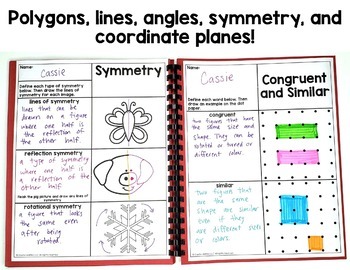Geometry Book Project
- Zip
What educators are saying
Description
This 40 page pack has everything you need to create a fun, hands-on way to end your geometry units. You can use this as a formative or summative assessment or a portfolio. It covers geometry topics such as polygons, quadrilaterals, attributes of shapes, partitioning shapes, symmetry, shape transformations, coordinate planes, and more! You can pick and choose which pages you want to use and then grade it using the included EDITABLE rubric!
Included Pages:
- Geometry Vocabulary
- 2D Shapes
- 3D Shapes
- Composing Shapes
- Types of Lines
- Types of Angles
- Hierarchy of Shapes
- Quadrilaterals (several versions)
- Polygons
- Polygons in Real Life
- Partitioning Shapes (several versions)
- Types of Triangles
- Shape Transformations
- Symmetry
- Tessellations
- Coordinate planes (two versions)
You will also receive an EDITABLE rubric for easy grading and feedback.
Hands-on and Engaging Activities
Students will feel engaged and motivated as they practice understanding, creating, and interpreting arrays. These activities go well beyond boring worksheets and really get your students involved in their own learning.
Perfect for Introducing Fraction Concepts
Anchor charts are powerful tools for learning and understanding new or abstract concepts. By filling out these anchor charts with your students, you will help them gain a deeper understanding of fraction concepts.
Ideas for Use
These activities work well in:
● Math centers
● Small groups
● Partner work
● Whole Class
Print-and-Go Materials
All Create-abilities resources are designed with ease-of-use in mind. Don’t have a color printer? No problem. Pages that do not render well in black-and-white have black-and-white copies included. Be classroom-ready with a quick print.
Check out my preview for a closer look at this product!
Feedback is greatly appreciated!!
★★★★You Might Also Like★★★★
● Multiplication Graphing Freebie
● Factors and Multiples Book and Task Cards
● Order of Operations Math Game
● Area and Perimeter Poster and Activity Set
Enjoy!





